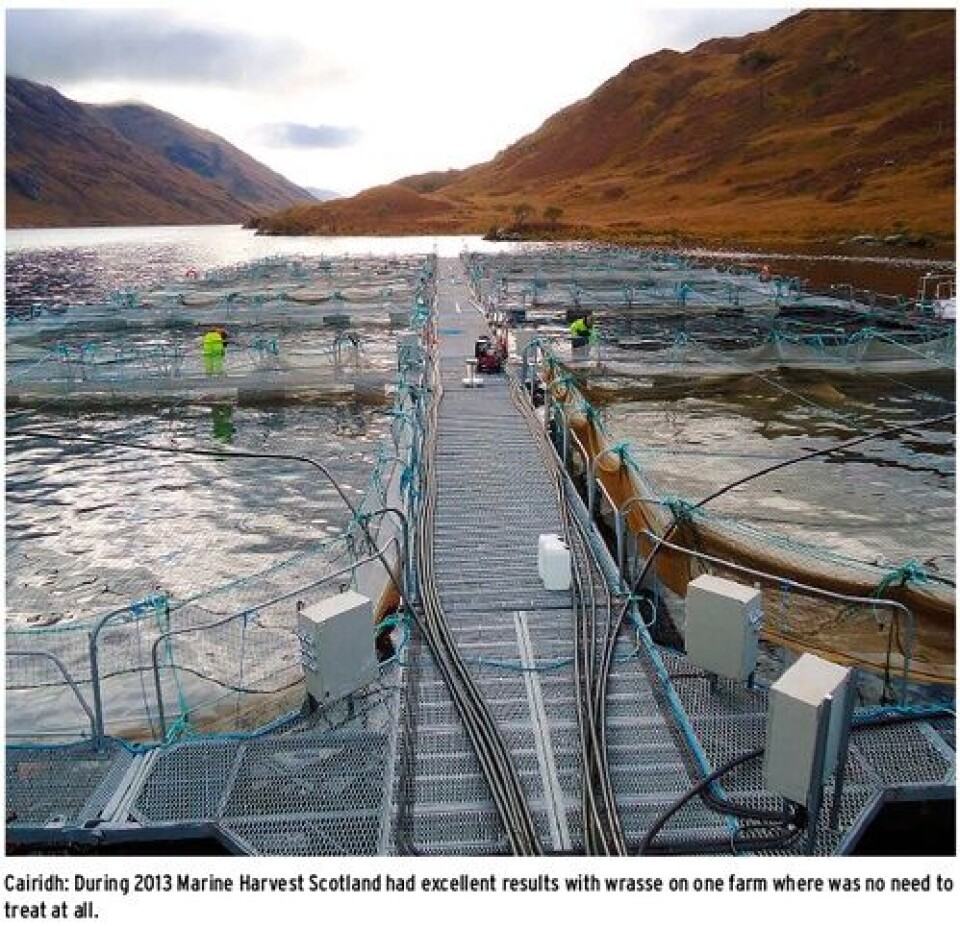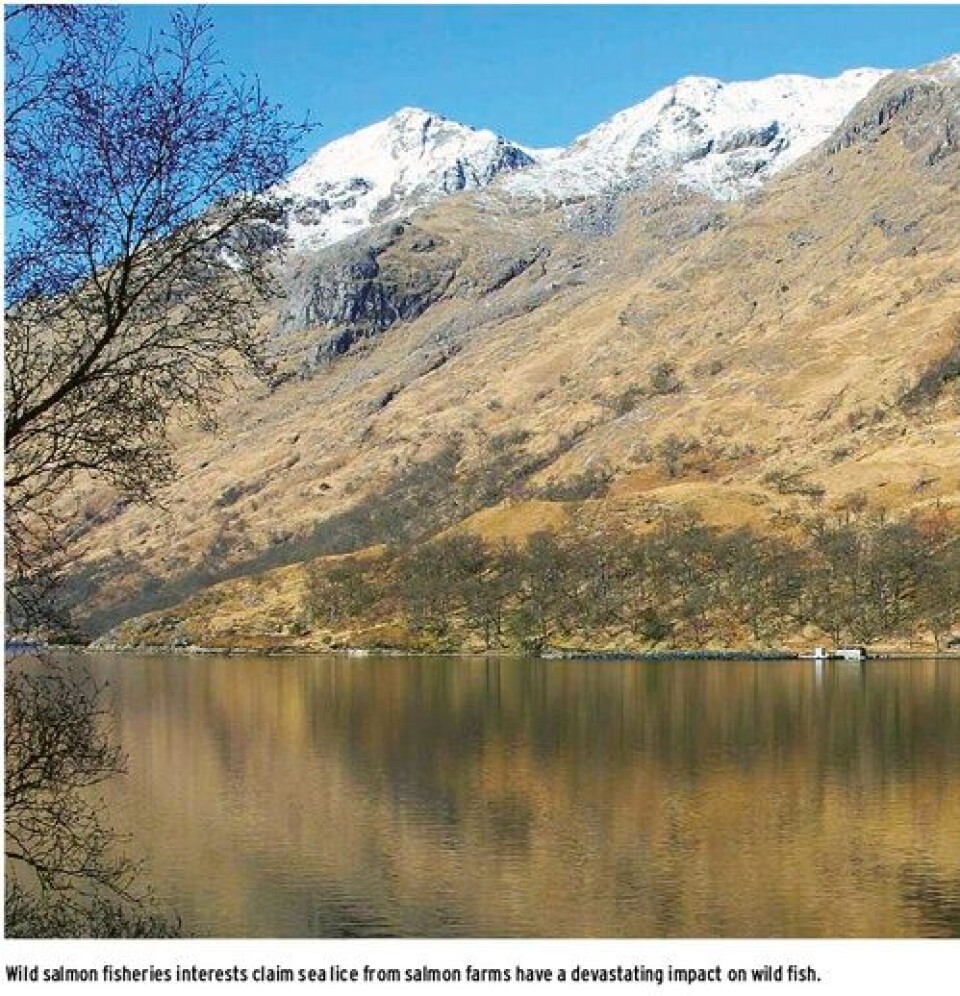New approach to sea lice control
By Siri Elise Dybdal siri@fishfarmingxpert.com

Sea lice continue to be a problem in salmon farming around the world. In Scotland, the industry has pioneered the development and application of integrated sea lice management strategies. These strategies take a holistic approach to lice management and control, based on the use of licensed and approved sea lice treatment medicines, single year class production, area management, synchronisation of production, and fallowing at the end of the production cycle. More recently, biological control, involving the use of the cleaner fish wrasse, has emerged and this has been added to the list of options available to the farmers.
However, conservationists and wild salmon fisheries interests claim sea lice from salmon farms have a devastating impact on wild fish, and many are campaigning for closed containment as the only option. This, they say, would provide full protection against sea lice infestations and disease. Now it looks more likely than ever that a commercial closed containment salmon farm could become a reality in Scotland. This year, the company FishFrom is planning to build the world’s first large land based salmon farm on the Scottish West coast.
The company claims the farm will act like a “biological firewall”, but the industry is sceptical about matters such as costs, stocking density and energy use: “A recent critical review of closed containment systems concluded they do not offer adequate advantages to the Scottish salmon sector. The many disadvantages that were highlighted included higher levels of energy, greater environmental footprint, higher stocking densities, higher level of capital and operating costs and higher prices for the consumer,” a Scottish Salmon Producers’ Organisation (SSPO) spokesperson told FishfarmingXpert.
Number one priority The latest SSPO fish health lice data from July until September 2013 showed generally low lice levels as expected, according to the SSPO. Although, the data revealed that in certain areas the lice level was considerably higher than others. The results for the remainder of 2013 are yet not published.
“Sea lice remain our number one priority, which I would say is the same for all salmon farmers,” says Steve Bracken, business support manager at Marine Harvest (Scotland) Ltd
His company is one of the producers that have introduced wrasse as a control measure against sea lice. He says the employment of wrasse have proven very successful and is now hoping to build further on their experience: “During 2013 we had excellent results with wrasse on one farm where we had no need to treat at all. The focus in 2014 is to build on that result,” Bracken adds.

Another leading producer, the Scottish Salmon Company (SSC) also admits that sea lice continue to challenge the industry: “It is recognised across the industry that sea lice - a naturally occurring parasite on healthy farmed fish - continue to be a challenge. “At The Scottish Salmon Company, excellent animal husbandry and health management practices are at the forefront of our efforts to maintain the optimum conditions for growing the high quality salmon, which we sell worldwide. “Where the Group has experienced increased levels of sea lice, this has been dealt with according to industry best practice. “Fish health for stock to be harvested in 2014 is however performing satisfactorily with no major biological challenges and normal growth,” a company spokesperson says. Like Marine Harvest Scotland, the development of commercially farmed ballan wrasse as a natural biological method to control and minimise the impact of sea lice, is central to SSC’s strategy to combat incidence of lice: “This common sea fish is proven to be an effective ‘cleaner fish’ which ‘eats’ the sea lice off salmon. Working with a range of industry partners across two separate projects SSC has been developing the initiative over a four year period,” the company says.
Controversial debate Scientists have been debating the possible effects of sea lice on populations of wild salmon and sea trout in Scottish coastal waters since the late 1980s. Over the past two years or so, the debate has become very much more public than previously, with anti-fish farming campaigners claiming that fish farms are at the heart of the problem and that the other factors affecting wild salmon and sea trout are much less significant.
To help inform this debate, the Scottish salmon farming industry last year began publishing detailed information on the management and control of sea lice in each of 30 geographical regions covering the west coast and western and northern isles. These regions were chosen to allow parallel information on wild salmon and sea trout fisheries within these areas to be presented by the wild salmonid fisheries sectors
“Bringing information from farmed and wild fisheries sectors together will create an important tool that will help in our understanding of the nature and effect of any interactions that might be taking place. “The SSPO has invited the wild salmonid fisheries sector to come forward with information on wild fisheries (i.e. catch returns, fishing effort, relevant aspects of wild fish health, sea lice levels, fishery specific information etc.), being aware that this information is held by them. We hope that the value of matching farmed and wild fish information against each other will be recognised and we look forward to working with the wild fisheries sector on this important project,” the SSPO stated in its latest Health Management Report.
However, despite repeated requests for information that parallels what the salmon farmers are publishing, no efforts have yet been made by the wild fisheries to share this for the common good - and the accusation against the salmon industry continues. For example, in December last year, the Salmon and Trout Association (Scotland) announced that it was asking major supermarket chain Asda to take a stand for wild salmon conservation by ending its relationship with the salmon producer Wester Ross Fisheries Limited, because of its “appalling sea-lice record and the threat that poses to wild salmon and sea trout.”
First contained mega farm One business that is attempting a new approach to control sea lice is FishFrom. In December 2013 the company secured planning consent from Argyll and Bute Planning Committee for the siting of its first 3,000 tonne salmon facility just north of Tayinloan on the Kintyre Peninsular.

The land based salmon farm will be the first of its kind in the UK. All production will happen in a controlled environment with highly oxygenated, recirculated water free from predators and disease, with temperature and light maintained at optimum conditions for fish health and growth. As the fish grow they will be graded into different tanks using the latest recirculation technology. The farm will be using 99.5 per cent recycled and filtered water
“We will produce salmon faster, more sustainably and more predictably than traditional methods allow. We plan on producing 3000 tons of salmon each year. The fish will grow from 100 grams to 5kg in nine months in the contained farm. “In the first year of production we expect a turnover £12 million generating £5million in operating profit,” says Andrew Robertson, the firm’s director.
The latest recirculation aquaculture technology is being supplied by a Danish firm. As a consequence, the Danish Government, through their export finance agency EKF, is proposing provision of an AAA rated guarantee of 80% of the debt finance. The company is currently working on securing investors as it is looking for a £18million capital investment.
FishFrom hopes to start building the site before June 2014. If all goes to plan, early the following year it will start to grow salmon smolts. The aim is to have the first fish on supermarket shelves in time for Christmas 2015. The company already have a written contract with a seafood supplier for its entire annual output.
No getting in or out “Primarily we will create a complete biological firewall between the farm and the surrounding environment. This means that there will be no parasites getting in and no fish getting out. Interaction with the marine environment does not happen. Our fish will not suffer due to sea lice infestations, jelly fish, algal bloom, storms and seals. They will not be able to escape and cross fertilize with wild salmon. We don’t lose feed, everything is monitored by camera. It is a seriously controlled environment.
“All our waste streams are contained as well and re-used for biogas or fertiliser”.
“There is no effect on the local environment and equally our mortality rate will be minimized as the fish will not be impacted by the same levels of stress,” says Robertson.
The plant will be powered by roof-mounted photovoltaic panels installed by one of the UK’s leading renewable energy companies. Backup power will be in the form of two onsite generators to ensure production is maintained in the event of power cuts.
Ragworm feed Another vital key differentiator is the feed, the company states. FishFrom has run extensive tests with different feed. One contained a smaller percentage of ragworms, one a larger percentage of ragworms and one only contained ragworms. There was also a standard fish meal and a soy feed in the trial.
“The full ragworm feed gave the best results, followed by the higher percentage ragworm feed, the lower percentage ragworm feed and then the standard feed,” says Robertson and adds that the full ragworm feed is actually cheaper to purchase also. “What this means is that our fish feed has no impact on wild fish stocks and is sustainable,” he emphasises. Taste trials have also shown that consumers prefer the fish they produce, which gives them full confidence in the product, Robertson says. Remains unconvinced According to FishFrom, fish are already being farmed in closed containment facilities in Spain, Denmark, the Netherlands, Ireland, North-America and China. They produce sea bass, catfish, and Atlantic salmon. However, the scale of the FishFrom’s site sets it apart.
He is aware that the industry is yet to be convinced: “At the moment, the industry is looking at us with a degree of suspicion. “But were we to be very successful, the industry would take a good look at it,” he claims. Costs were one of the issues raised by the SSPO, and Robertson agrees that the start-up costs will be substantial:
“The cost of the infrastructure, technology and tanks are significant,” he says and adds that they have had to increase the size of the project as a result.
“But once it is up and running, there will be no need for well boats, vaccination, sea lice treatments or fallowing. Our cost of production will be approximately 20 per cent less than in sea pens. We will know exactly what number of fish we have in the tanks. If you ask any fish farmers how many fish are out in the pens, they wouldn’t know. Our operation is direct and transparent,” he claims.
Spreading around the world Robertson says the FishFrom “kit” could easily be replicated around the world and for farming different species. He claims the model is a long term solution that would greatly improve the distribution of fish and points out that farms could be set up near cities, which would cut down on air miles and give inland cities access to fresh fish: “It will be produced in close proximity to the markets,” he says.
“Land based aquaculture has been around for thousands of years, but now technology has been significantly enhanced for us to use on a commercial scale. The benefits are many and varied and makes for more than a compelling business proposition,” Robertson concludes.






















































